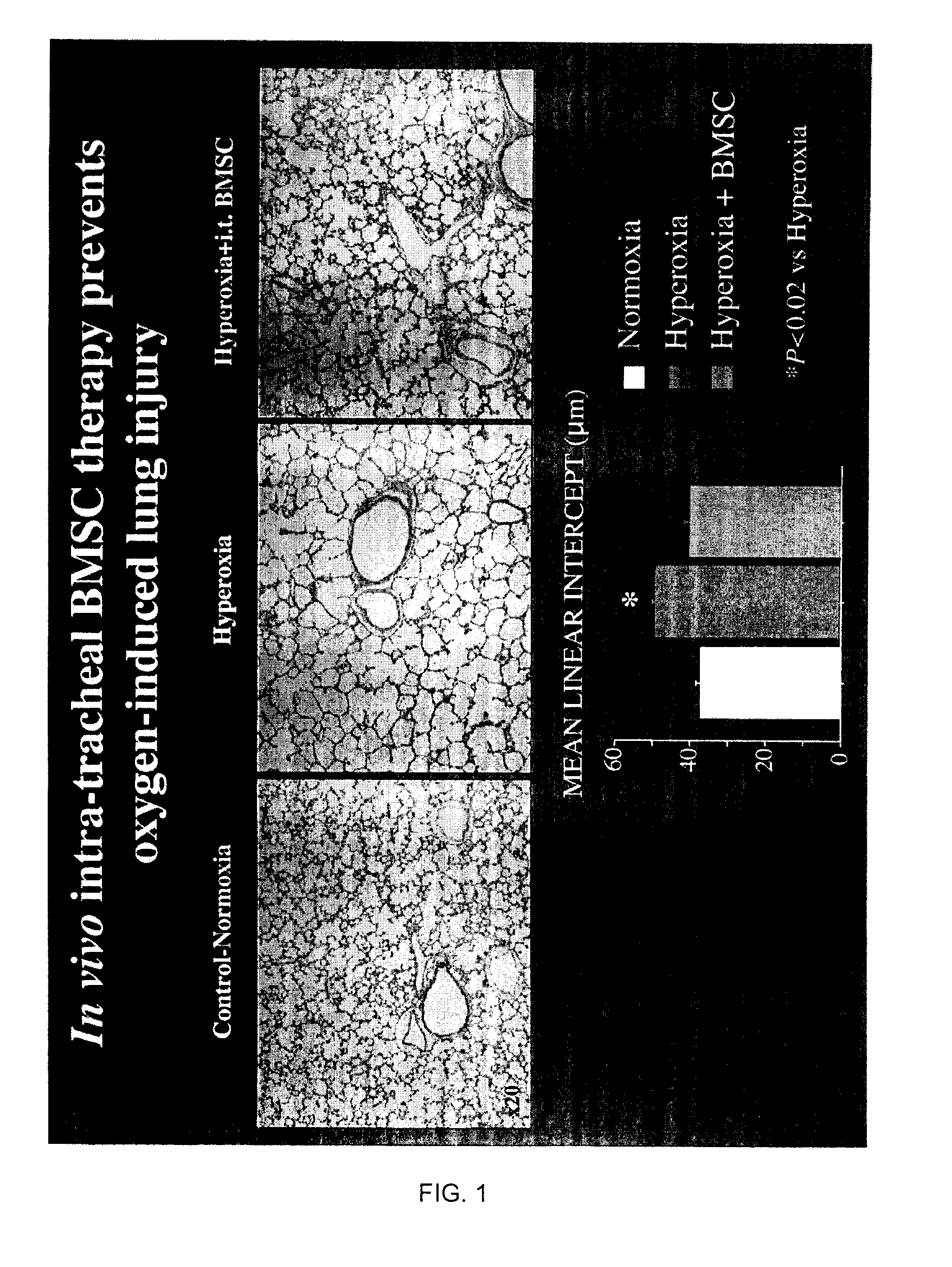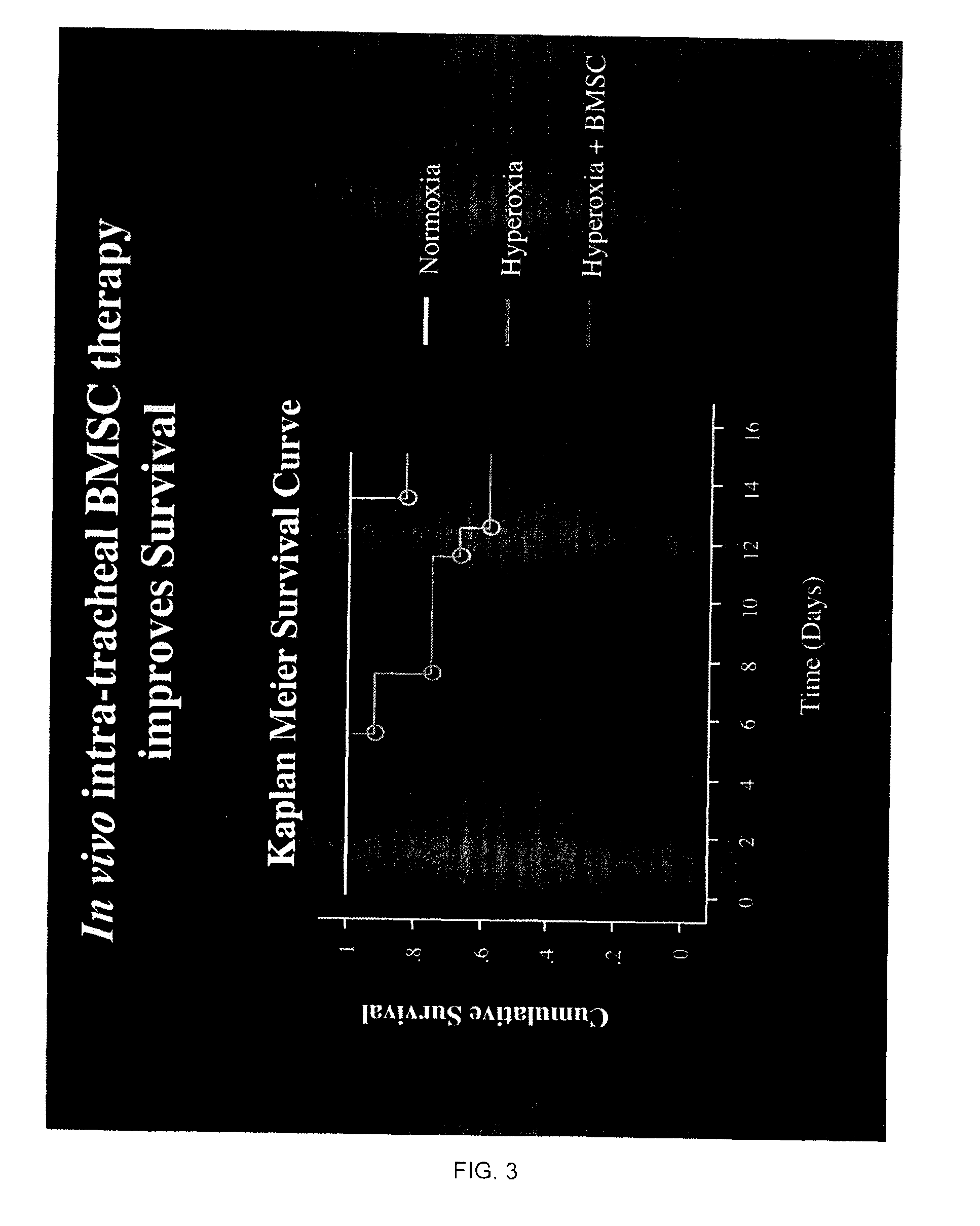Stem Cells For Treating Lung Diseases
a technology of stem cells and lung diseases, applied in the field of stem cells, can solve the problems of no therapeutic benefit, increased health care costs, and high risk of lung and brain long-term injury in infants, and achieve the effect of improving lung distribution and enhancing therapeutic
- Summary
- Abstract
- Description
- Claims
- Application Information
AI Technical Summary
Benefits of technology
Problems solved by technology
Method used
Image
Examples
example 1
[0078]a. We tested the hypothesis that bone-marrow (BM)-derived and human umbilical cord blood (hUCB)-derived mesenchymal stem cells (MSC) would be able to prevent oxygen-induced lung injury in a newborn rat model mimicking human BPD. Because the lung is relatively accessible for drug delivery via the airway and because this route of administration is clinically pertinent, we choose to administer the stem cells via intratracheal injection. The animal model involves exposure of newborn rat pups to 95% oxygen from birth to 14 days postnatal. This creates lung injury similar to human BPD and is irreversible in this animal model, suggesting that the intrinsic repair mechanisms of the lung are overwhelmed. In vivo intra-tracheal administration of mesenchymal stem cells is performed through intratracheal puncture at 4 days of age.
[0079]After halothane anesthesia, the trachea is exposed through a neck-incision. Stem cells (25 μl) are then delivered through a tracheal puncture with a short,...
example 2
[0081]Our results show that BM-derived MSC and hUCB-derived stem cells engraft into the alveolar epithelium and prevent alveolar damage. To explore the mechanisms of this therapeutic benefit, we performed in vitro (cell culture experiments) and showed that BM-derived MSC, when in contact with oxygen-injured lung can adopt a lung phenotype by expressing surfactant protein C(SP-C) a specific marker for alveolar type 2 cells.
example 3
[0082]Isolation of Murine MSCs and Alveolar Type II Cells. MSCs were isolated from mouse bone marrow as described (7) except that whole bone marrow was plated at a density of 1.46×106 cells per cm2 and cultured for 8-10 days before harvest. MSCs (up to 40×106 cells) were added to M-280 Dynabeads (five beads per cell; Dynal, Oslo) conjugated to an anti-CD11b antibody (10 μg per mg of beads; PharMingen) in a volume of 1 ml and incubated on a rotator at 4° C. for 45 min. Successive rounds of immunodepletion by using antibodies against CD34 and CD45 (PharMingen) were conducted similarly. Immunodepleted cells were suspended in Hanks' balanced salt solution and used for further experiments as described. Alveolar epithelial type II cells were isolated from the lung tissue. Approximately 2×106 cells were used to prepare genomic DNA for real-time PCR. Alternatively, 5×104 cells were cultured and fixed on positively charged slides for analysis by fluorescence in situ hybridization (FISH).
PUM
| Property | Measurement | Unit |
|---|---|---|
| quantitative real time RT- | aaaaa | aaaaa |
| volume | aaaaa | aaaaa |
| diameter | aaaaa | aaaaa |
Abstract
Description
Claims
Application Information
 Login to View More
Login to View More - R&D
- Intellectual Property
- Life Sciences
- Materials
- Tech Scout
- Unparalleled Data Quality
- Higher Quality Content
- 60% Fewer Hallucinations
Browse by: Latest US Patents, China's latest patents, Technical Efficacy Thesaurus, Application Domain, Technology Topic, Popular Technical Reports.
© 2025 PatSnap. All rights reserved.Legal|Privacy policy|Modern Slavery Act Transparency Statement|Sitemap|About US| Contact US: help@patsnap.com



